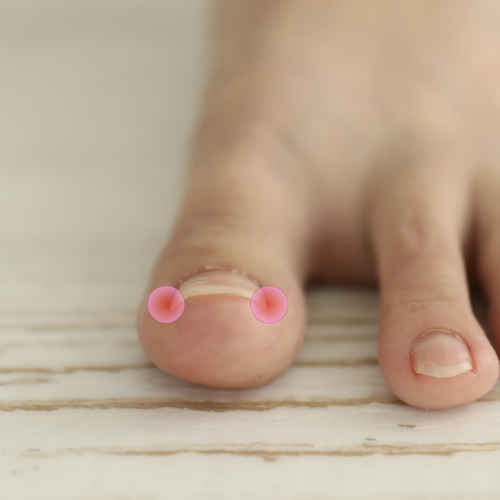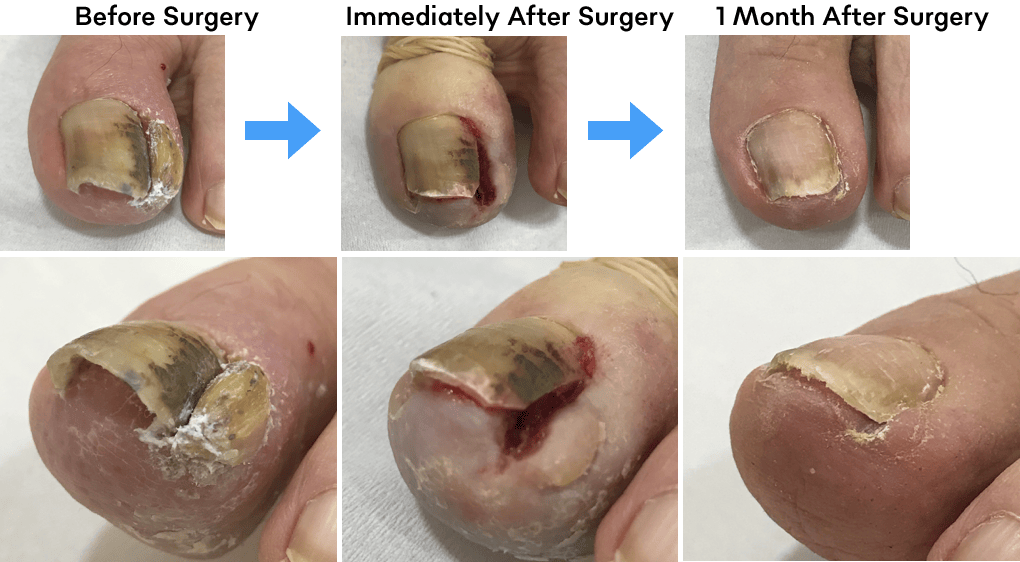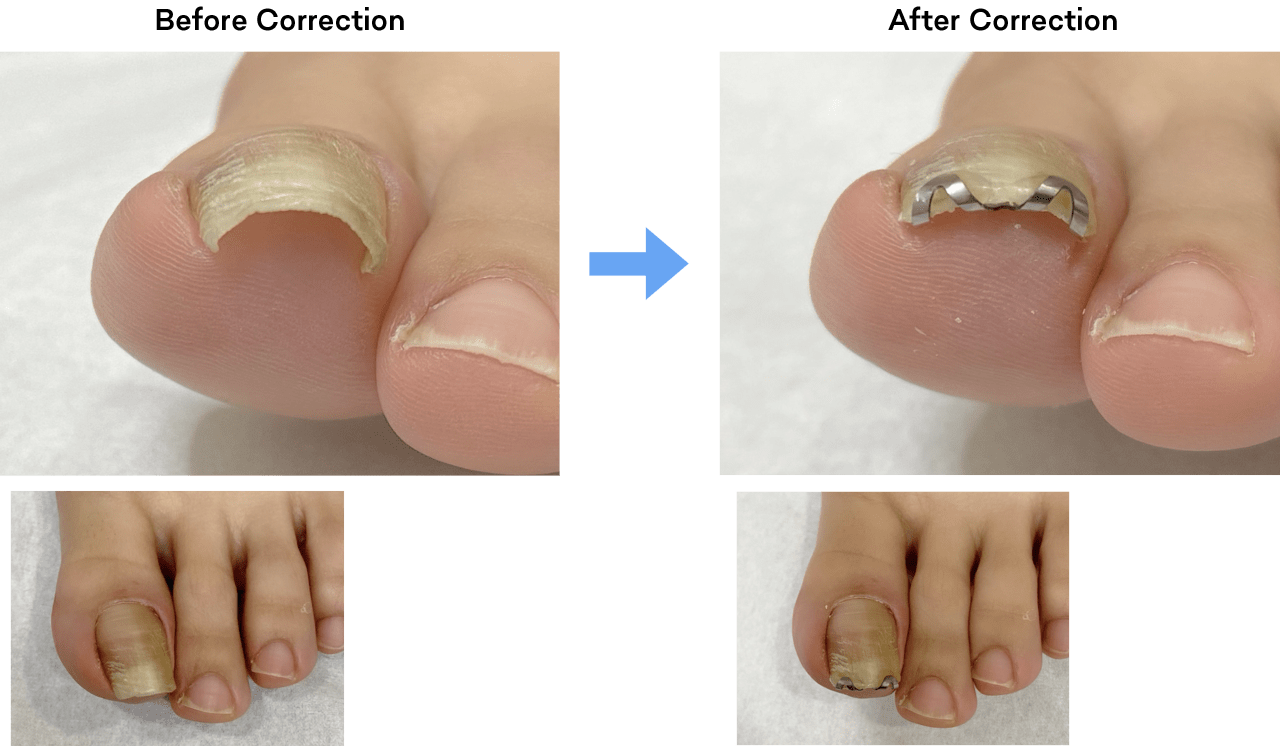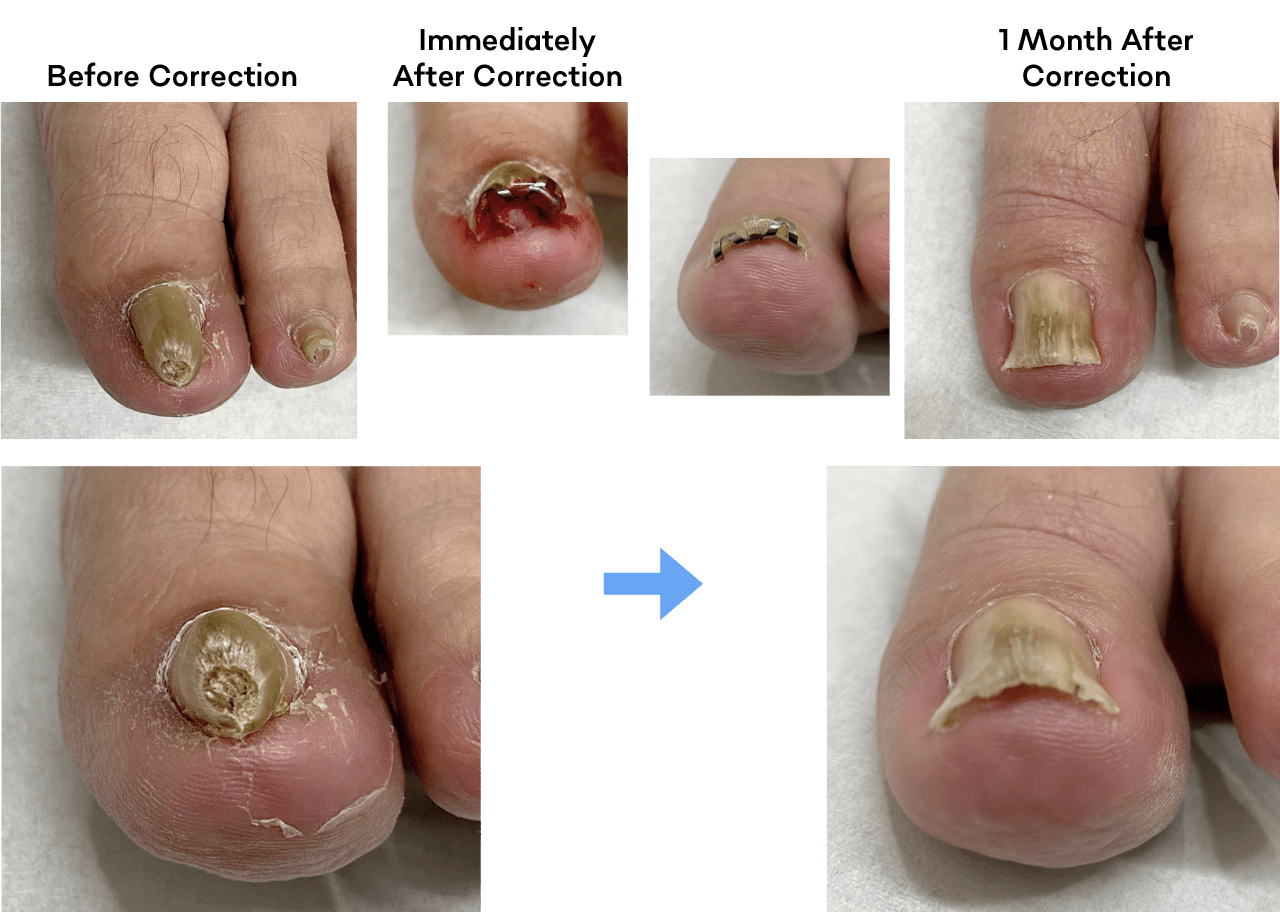Treatable ConditionsSupervised by Foot Clinic Omotesando
Ingrown Toenail

“Ingrown toenail” refers to a condition where the nail grows inward and digs into the skin, causing pain and inflammation. In severe cases, the nail can penetrate the skin, leading to bacterial infections, pus, and the formation of painful granulation tissue that can bleed and emit an odor.
While it may seem that the nail itself is the cause, in many cases the underlying issue is related to the structure of the foot.
Toenails naturally tend to curl if the toes do not receive proper pressure from underneath. This can happen to people with floating toes, bedridden patients, or those with foot deformities such as flat feet, bunions, or hallux rigidus, which prevent proper load distribution.
In some cases, it’s not the nail that digs into the skin but rather the twisted toe pressing against the nail. A rigid big toe can also lead to improper push-off when walking, causing nail deformities.
People with naturally wide nails are also at higher risk.
Children’s nails are especially thin and vulnerable. Crawling babies tend to push off with their big toes, causing the nails to curve upwards. As they begin walking, tiptoe movements—like reaching for objects—can lead to nail cracking or deformities. Most cases resolve with growth, but if the deformity progresses, please consult us.
-

Mechanism of Ingrown Toenail
Common Risk Factors:
– Floating toes
– Bedridden condition
– Deformities such as bunions, flat feet, or hallux rigidus
– Naturally wide nails
A common misconception is that deep trimming (overcutting) is the direct cause. In reality, people who are already prone to ingrown nails develop it when deep trimming worsens the condition.
Since the underlying cause is often not the nail itself, treatment at Foot Clinic Omotesando involves assessing the patient’s foot structure, lifestyle, and walking habits. For severe cases, surgical correction may be necessary for a complete cure.
Treatment Options at Foot Clinic Omotesando:
■ VHO Wire Correction:
A specialized wire inserted to correct the nail curvature. The VHO wire system, certified at Foot Clinic Omotesando, is less invasive, suitable even for short nails, and has minimal discomfort. Note: This is not covered by insurance. Please contact us for pricing details.
* For detailed procedure information, refer to this page (Japanese).
-

VHO Wire Correction
■ Surgical Treatment (Phenol Procedure): A widely used outpatient procedure that takes about 15 minutes. Patients can walk home after surgery and simply wash the area and apply ointment starting the next day. It requires minimal follow-up visits for full recovery.
-

Phenol Procedure
■ Self-Correction Tools: For mild cases or recurrence prevention, over-the-counter correction devices are an option. One such device is the “Nail Aid” (a Class I medical device developed by foot specialists at a university hospital). It can be reused and is available for purchase online.
-

Nail Aid Correction
■ Correction Under Local Anesthesia: For severe deformities where standard correction is ineffective but surgical removal would excessively reduce nail width, we offer correction under local anesthesia. The nail is flattened during the procedure and fixed in place with a medical-grade plastic along with Nail Aid. Only the initial procedure requires anesthesia; follow-up visits do not.
-

Correction Under Local Anesthesia
Treatable Conditions Supervised by Omotesando Foot Clinic
- Joint Pain & Deformities
- Bunion (Hallux Valgus)
- Hallux Rigidus
- Hammer Toe / Claw Toe / Mallet Toe
- Gout Attack
- Lisfranc Joint Disorder
- Rheumatoid Arthritis
- Osteoarthritis of the Ankle
- Toenail Disorders
- Ingrown Toenail (Onychocryptosis)
- Thickened Toenail (Onychauxis)
- Double Toenail
- Toenail Fungal Infection (Onychomycosis)
- Muscle, Tendon, and Ligament Pain
- Plantar Fasciitis
- Achilles Enthesopathy
- Peroneal Tendon Subluxation
- Posterior Tibial Tendon Dysfunction
- Flexor Hallucis Longus Tendinitis
- Bone-Related Pain
- Sesamoiditis (Pain in the Big Toe)
- Metatarsal Head Pain
- Os Trigonum Syndrome
- Accessory Navicular Syndrome
- Osteochondrosis (Sever’s Disease etc.)
- Sinus Tarsi Syndrome
- Stress Fracture
- Foot Numbness
- Morton's Neuroma
- Tarsal Tunnel Syndrome
- Diabetic Peripheral Neuropathy
- Foot Lumps & Lesions
- Corns / Calluses / Warts
- Subungual Exostosis
- Glomus Tumor
- Plantar Fibromatosis
- Ganglion Cyst
- Epidermoid Cyst (Atheroma)
- Sports & Foot Health
- Causes of Pain (Threshold Changes)
- Pes Anserine Bursitis (Inner Knee Pain)
- Iliotibial Band Syndrome (Outer Knee Pain)
- Shin Splints
- Ankle Sprain (Lateral Ligament Injury)
- Lisfranc Ligament Injury
- Common Pediatric Foot Conditions
- The Arch as the Foundation of Growth
![Foot Clinic OMOTESANDO [Ashi no Clinic OMOTESANDO]](/img/en/cmn/logo1.svg)




